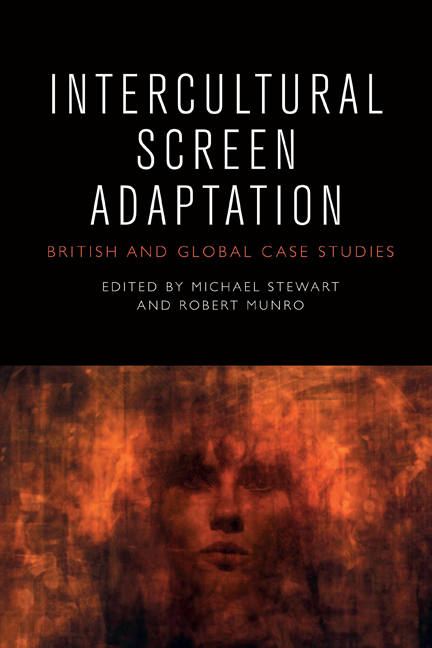Book contents
- Frontmatter
- Contents
- List of Illustrations
- Acknowledgements
- List of Contributors
- Introduction
- PART I NOSTALGIA, HERITAGE AND THE TOURIST GAZE
- 1 Adapting Pagnol and Provence
- 2 ‘A Tourist in Your Own Youth’: Spatialised Nostalgia in T2: Trainspotting
- 3 ‘200 Miles Outside London’: The Tourist Gaze of Far from the Madding Crowd
- PART II RADICAL CONTINGENCIES: NEGLECTED FIGURES AND TEXTS
- 4 Reframing Performance: The British New Wave on Stage and Screen
- 5 Why We Do Not Adapt Jean Rhys
- PART III RE-ENVISIONING THE NATIONAL IMAGINARY
- 6 ‘To see oursels as ithers see us’: Textual, Individual and National Other-selves in Under the Skin
- 7 Back to the Future: Recalcitrance and Fidelity in Julieta
- PART IV THE LOCAL, THE GLOBAL AND THE COSMOPOLITAN
- 8 El Patrón Del Mal: A National Adaptation and Narcos Precedent
- 9 Constructing Nationhood in a Transnational Context: BBC’s 2016 War and Peace
- 10 The Beautiful Lie: Radical Recalibration and Nationhood
- PART V REMAKING, TRANSLATING: DIALOGUES ACROSS BORDERS
- 11 In Another Time and Place: Translating Gothic Romance in The Handmaiden
- 12 Chains of Adaptation: From D’entre les morts to Vertigo, La Jetée and Twelve Monkeys
- 13 A ‘Double Take’ on the Nation(al) in the Dutch-Flemish Monolingual Film Remake
- Index
6 - ‘To see oursels as ithers see us’: Textual, Individual and National Other-selves in Under the Skin
Published online by Cambridge University Press: 22 September 2020
- Frontmatter
- Contents
- List of Illustrations
- Acknowledgements
- List of Contributors
- Introduction
- PART I NOSTALGIA, HERITAGE AND THE TOURIST GAZE
- 1 Adapting Pagnol and Provence
- 2 ‘A Tourist in Your Own Youth’: Spatialised Nostalgia in T2: Trainspotting
- 3 ‘200 Miles Outside London’: The Tourist Gaze of Far from the Madding Crowd
- PART II RADICAL CONTINGENCIES: NEGLECTED FIGURES AND TEXTS
- 4 Reframing Performance: The British New Wave on Stage and Screen
- 5 Why We Do Not Adapt Jean Rhys
- PART III RE-ENVISIONING THE NATIONAL IMAGINARY
- 6 ‘To see oursels as ithers see us’: Textual, Individual and National Other-selves in Under the Skin
- 7 Back to the Future: Recalcitrance and Fidelity in Julieta
- PART IV THE LOCAL, THE GLOBAL AND THE COSMOPOLITAN
- 8 El Patrón Del Mal: A National Adaptation and Narcos Precedent
- 9 Constructing Nationhood in a Transnational Context: BBC’s 2016 War and Peace
- 10 The Beautiful Lie: Radical Recalibration and Nationhood
- PART V REMAKING, TRANSLATING: DIALOGUES ACROSS BORDERS
- 11 In Another Time and Place: Translating Gothic Romance in The Handmaiden
- 12 Chains of Adaptation: From D’entre les morts to Vertigo, La Jetée and Twelve Monkeys
- 13 A ‘Double Take’ on the Nation(al) in the Dutch-Flemish Monolingual Film Remake
- Index
Summary
In Robert Burns's ‘To a Louse’ (2001 [1786]), the narrator reflects upon the sight of a louse upon the head of a pompous woman in a church. The host body is unaware of its alien invader, and Burns's narrator cannot help but reflect upon the impropriety of the louse marauding upon its aristocratic body. By the end of the poem the entire congregation of the church titters at the haughty woman with the louse on her head, leading Burns to reflect:
O wad some Pow’r the giftie gie us
To see oursels as ithers see us! (2001 [1786]: 133)
Burns's poem is a call for greater self-awareness and objectivity, a desire that we can view our affectations and pretensions from a distance. The congregation has gained this at the expense of the woman with the louse in her hair. They have gained a little greater insight into their selves by their look at an ‘other’, the haughty woman, whose lack of self-awareness causes their mirth. In this chapter I examine the film Under the Skin (Glazer 2013) which performs a meditation on selves, others and other-selves in its depiction of an alien predator in the form of a human female who begins to explore its (her) potential to adopt a human, and female, consciousness with fatal consequences. I will begin by exploring Hegel's work on self-consciousness and his dialectic on self and other which, I argue, is one level to read the film's narrative concern as outlined above.
In his definitive work, The Phenomenology of Spirit (1807), Hegel advanced the problem of consciousness as outlined by René Descartes, whose famous appropriation ‘I think therefore I am’ proposed to solve the problem of epistemology by asserting that mind and matter were separate entities. In this sense human consciousness was independent from the materiality of the human body; it arrived from a greater power. As discussed by Pippin (2010), this led to the problem of how these two distinct entities interacted with one another, which was elaborated upon by Immanuel Kant's description of the subject– object relationship. Kant developed a theory of self-consciousness which argued that in order to bridge the subject–object divide, an awareness of the self as a subject was crucial to apprehending a material object that was distinct from the self.
- Type
- Chapter
- Information
- Intercultural Screen AdaptationBritish and Global Case Studies, pp. 101 - 119Publisher: Edinburgh University PressPrint publication year: 2020



